Birdwatching, or “twitching,” as colloquially termed, has evolved from a casual pastime into a profound cultural and scientific endeavour. Birdwatching history intertwines exploration, scientific discovery, and wildlife enthusiasm, revealing the beauty of birds in their natural habitats. Kenya‘s abundance of bird species showcases the nation’s rich biodiversity and provides a front-row seat to bird lovers. Renowned for its diverse environments, Kenya proves to be an exceptional destination for a birdwatching holiday. The nation boasts many habitats, contributing to a remarkably varied bird population. Whether at the majestic heights of Mount Kenya or the tranquil shores of its lakes, each region is graced by a unique cast of bird species.
In this guide for birdwatchers, we explore the fascinating bird species that reside in Kenya. So get ready, buckle up, and prepare for an awe-inspiring avian adventure.
Birds of Prey in Kenya
Other bird species aside, Kenya has a diverse range of raptors. African fish eagle and secretary bird are two impressive birds. The fish eagle can carry prey up to eight times its body weight, while the secretary bird has elegantly long legs and can stomp on the heads of snakes.
Let us first understand what makes these beasts masters of the game. Explained below are some of the adaptations that help Kenya’s birds of prey stay on top of the food chain.
Adaptations of Birds of Prey
Powerful Vision: Raptors have exceptional vision, which helps them hunt effectively. They have more light-sensitive cells in their eyes than humans. This allows them to spot prey from far away and target it accurately. For instance, the African Fish Eagle depends on its sharp eyesight to detect fish movements underwater.
Talons: Avian predators have nails precisely crafted to capture and subdue prey. Each bird species has unique adaptations tailored to their preferred hunting methods in the diverse landscapes of Kenya. A common example is that of the African Fish Eagle. The talons of the Martial Eagle can exert considerable force, allowing it to capture prey as large as small antelopes.
Hooked Beaks: Eagles and hawks’ formidable and curved beaks are versatile instruments for rending and devouring prey. These beaks, shaped by their carnivorous diets, play a crucial role in the survival and achievement of these magnificent hunters.
Territorial Acumen: Behavioural traits play a critical role, with territorial acumen an essential aspect. Establishing and defending territories is fundamental for birds of prey as it guarantees a predictable and stable food supply.
Let us dive deeper into some examples of Kenya’s prominent raptors.
The Secretary Bird
The Secretary bird is a large bird of prey that primarily lives on the ground. This bird species is found in Kenya and other parts of Africa, particularly in the sub-Saharan region’s open grasslands and savannah. This bird is easily recognizable due to its size of up to 1.3 meters. It has an eagle-like body and crane-like legs. Adults have a red-orange face with no feathers and predominantly grey feathers. Other features include a flattened dark crest, black flight feathers, and black thighs. The Secretary bird does not migrate, but it may follow food sources. It thrives in open grasslands, savannas, and shrublands. The Secretary Bird does prefer forests or dense shrubbery, which can interfere with its ability to move around on foot.
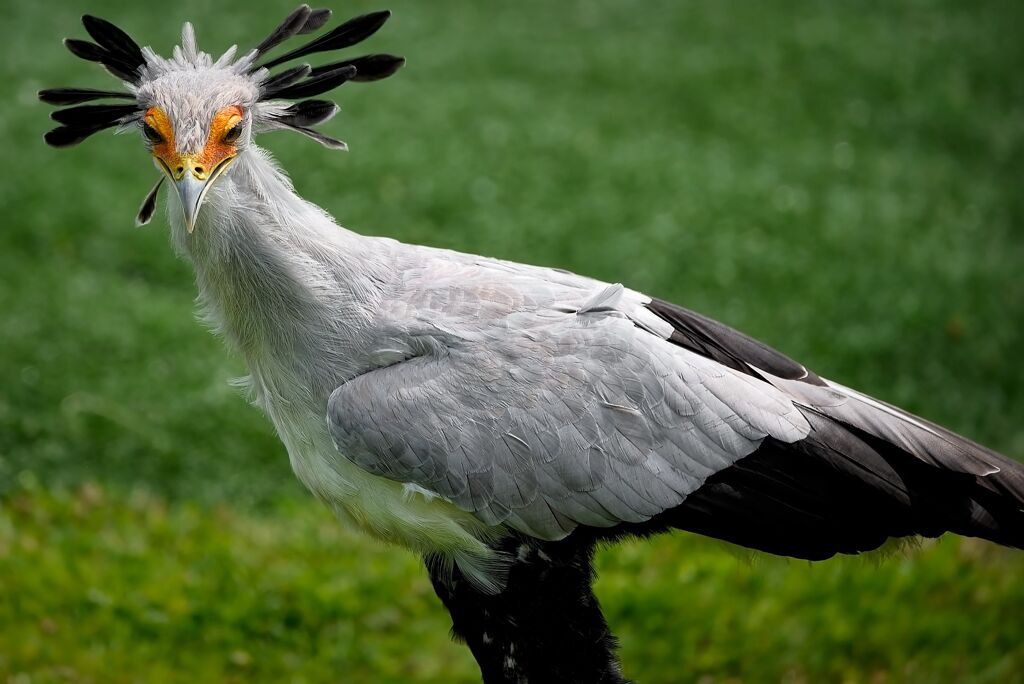
Bateleur Eagle
The Bateleur, a medium-sized eagle exclusive to Africa and parts of Arabia is a solitary marvel with a wide-ranging habitat. This diurnal bird has impressive foraging capabilities and covers approximately 650 square kilometres daily. Considered one of the most skilled hunters in Kenya, it preys on smaller bird species, small reptiles, mammals, and insects. It often outcompetes other scavengers to locate smaller carcasses. Noteworthy is its unique sunbathing ritual, where it stands upright with wings outstretched in a ‘phoenix’ pose. Additionally, the Bateleur engages in a fascinating behaviour called “praying.” During this act, the eagle allows ants to traverse its wings and feathers and then startles them. This peculiar act is a symbiotic relationship, as the ants secrete formic acid in self-defence, eliminating ticks and fleas.
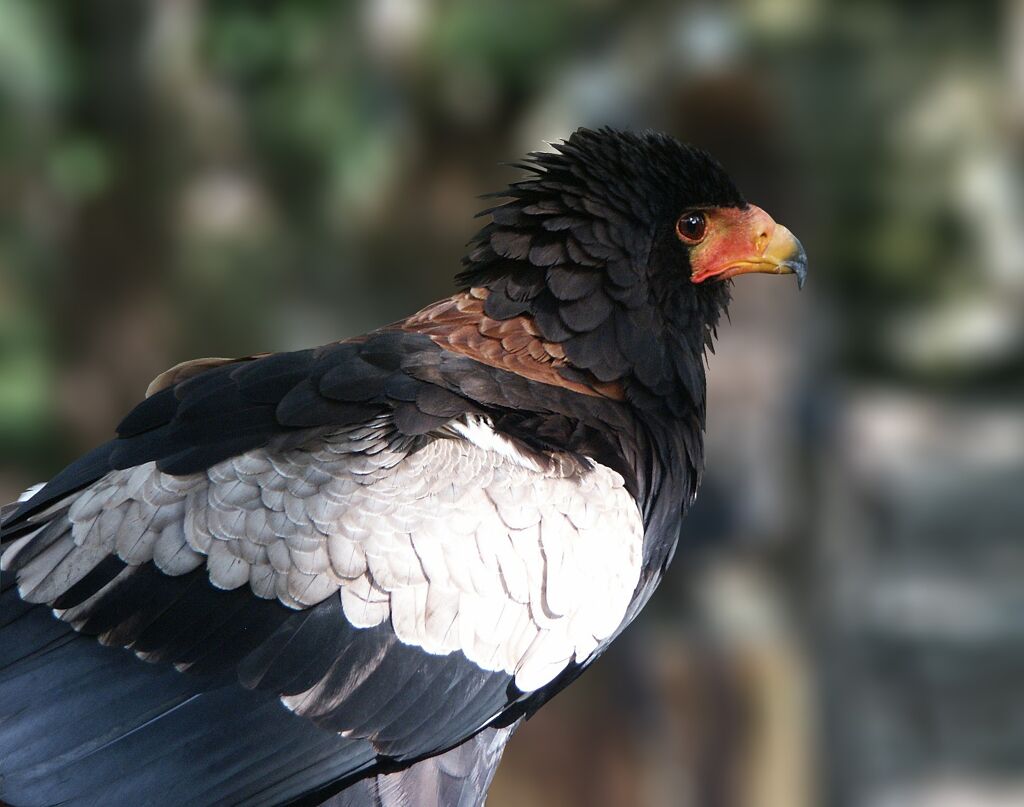
Tawny Eagle
The Tawny Eagle, a magnificent bird of prey, graces the expansive landscapes of Africa. This particular species thrives in open dry habitats such as deserts, savannas, and grasslands. Distinguished by a wingspan measuring 1.72 – 1.85 meters and a length of 65 – 72 centimetres, it has earned its place as a formidable hunter. The Tawny Eagle is an expert opportunist, preying on carrion, insects, and various small animals. Classified as diurnal and monogamous, these eagles form lifelong pairs, occupying territories for years.

African Fish Eagle
The African fish eagle is a large bird species common in Kenya and Subharan Africa. The bird is mostly sighted in areas with open water. It feeds primarily on fish, which it catches by swooping down from a tree and snatching them from the water. The eagle’s spicules, or structures on its toes, enable it to grasp slippery prey better. African Fish Eagles can drag fish across water or paddle to shore incase it is too heavy. It is also known for kleptoparasitism, stealing food from other birds. Fish aside, the African Fish Eagle feeds on smaller birds including domestic fowl, reptiles, and mammals.
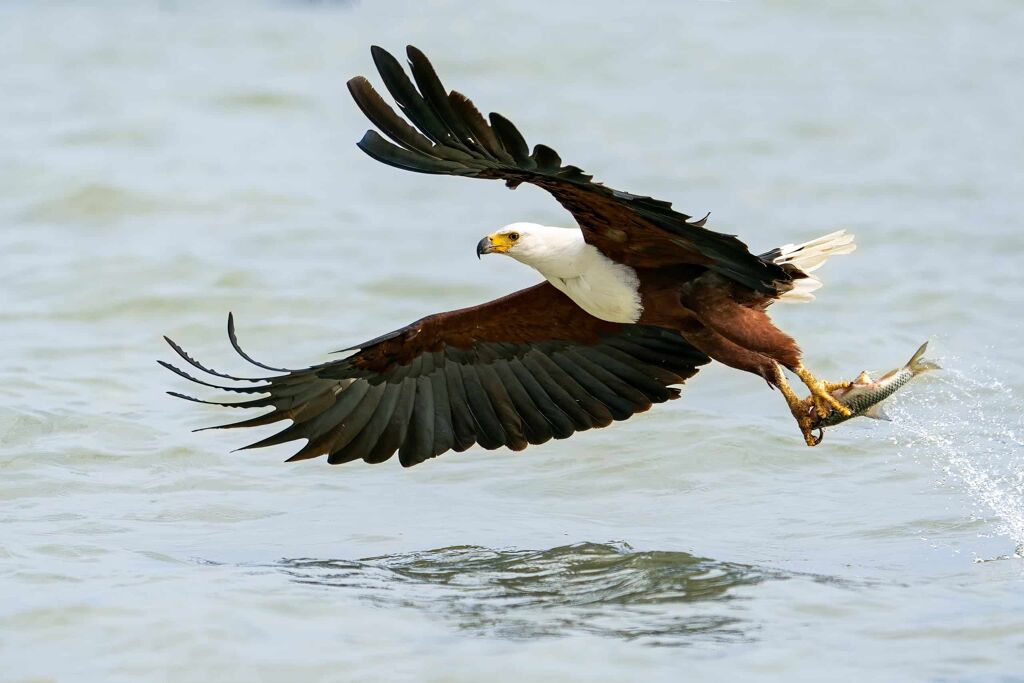
Black Chested Snake Eagle
The black-chested snake eagle, a formidable African bird species, boasts an expansive Afrotropical distribution covering Kenya. This partial migrant exhibits a versatile habitat range. Inhabiting open acacia woodlands, miombo woodlands, grasslands, thornbush savannas, and even semi-arid savanna and desert areas, it displays adaptability in its choice of dwelling. A notable feature is its tolerance for anthropogenic habitats, utilizing farmlands, electricity pylons, and telephone poles. Coexisting with the brown snake eagle, it shows remarkable nesting proximity without conflict. As a specialized predator, the black-chested snake eagle predominantly preys on snakes, including venomous ones up to 80 cm long. It also extends its diet to lizards, insects, small mammals, and frogs. Employing varied hunting techniques, it may perch, hover, or search the ground, demonstrating a calculated approach to capturing its diverse prey.

These aside, other birds of prey that call Kenya home include The Hooded Vulture, Martial Eagle, Long Crested Eagle, Steppe Eagle, Common Buzzard, Black Winged Kite, and The African Marsh Harrier.
Other Bird Species in Kenya
Pied Crow
The pied crow is a bird species widely distributed in Kenya and other parts of Africa. Its natural habitat is mainly open country with villages and towns nearby, but it does not occur in the equatorial rainforest region. Although it is not as reliant on urban life as the house crow, it is rarely seen far from human habitation. Typically, pied crows can be found in pairs or small groups, but a plentiful food source can attract many birds. The bird’s diet consists of injured insects, small invertebrates, small reptiles, small mammals, young birds and eggs, grain, peanuts, carrion, and human food scraps and fruit. The pied crow has been observed killing and eating Fruit Bats and is often seen scavenging around slaughterhouses, sometimes in huge numbers. The Maasai people call it Ol-korrok, named after the sound of its call.

Cinnamon-chested Bee-eater
The cinnamon-chested bee-eater is a relatively small bird species in Kenya and other parts of East Africa. This bird differs from the somewhat similar little bee-eater by their larger size, darker colouring, white cheek patches, and the upland habitat where they are found. This bird lives in upland regions, usually between 1,800 and 2,300m and occupies wooded hillsides and forest edges, clearings, plantations, and gardens. Their diet consists mainly of honeybees, although they also eat moths, butterflies, dragonflies, beetles, and other flying insects.

Pied Kingfisher
The pied kingfisher, a striking water kingfisher, graces the landscapes of Africa and Asia with its distinctive black and white plumage and unmistakable habit of hovering above clear lakes and rivers before executing precise dives for fish. It stands out with its double-banded breast marking for males and a single, sometimes broken, gorget for females. Often seen in pairs or small family groups, these birds display head-bobbing and tail-flicking behaviours while perched. Feeding primarily on fish, it demonstrates exceptional hunting prowess by hovering over the water to detect prey and executing a swift, vertical dive for capture. This agile bird can handle prey without returning to a perch, showcasing its ability to hunt over expansive water bodies or in estuaries without traditional perches required by other kingfisher species.
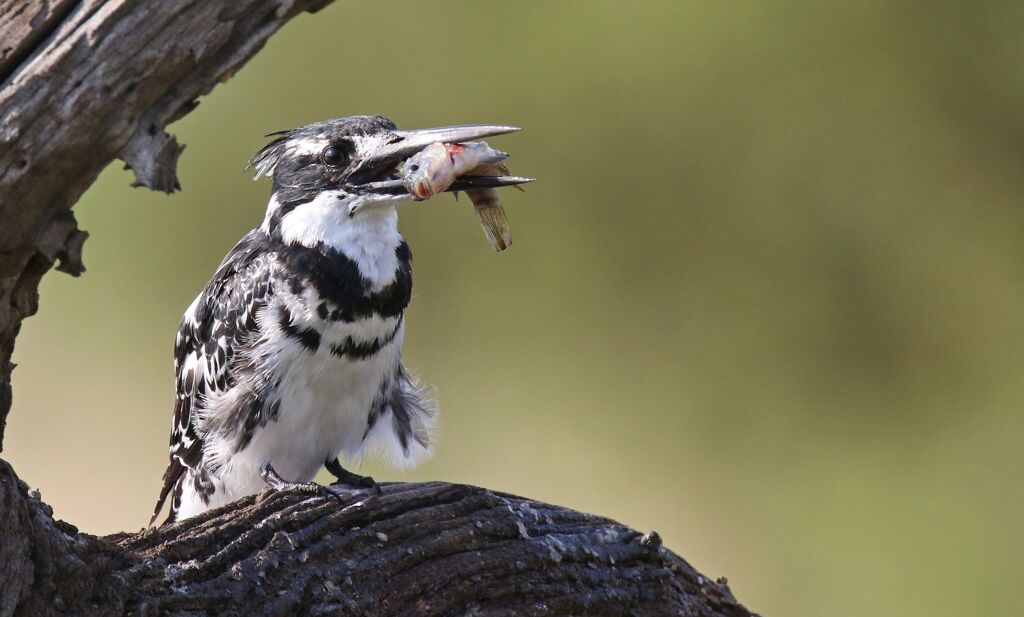
Grey Woodpecker
The Grey Woodpecker, a widespread resident breeder in Sub-Saharan and equatorial Africa, thrives in forested habitats. This woodpecker exhibits sexual dimorphism, with males boasting a red crown while females have a plain grey head. Measuring 20 cm in length, it displays the classic woodpecker shape with a straight pointed bill, zygodactyl feet, and a stiff tail for support against tree trunks. Nesting in tree holes, the Grey Woodpecker is a skilled insectivore, utilizing its long tongue to capture prey. Recognizable by its regular tapping or drumming, its loud and fast call, “peet-peet-peet-peet,” resonates through wooded habitats. Woodpeckers, known for tapping to find insects and excavate nest cavities, possess a unique adaptation—a tiny brain of just 0.07 ounces. This minimized brain size minimizes the risk of brain injury during pecking, showcasing the remarkable evolutionary adaptations that enable woodpeckers to engage in this behaviour without succumbing to headaches.
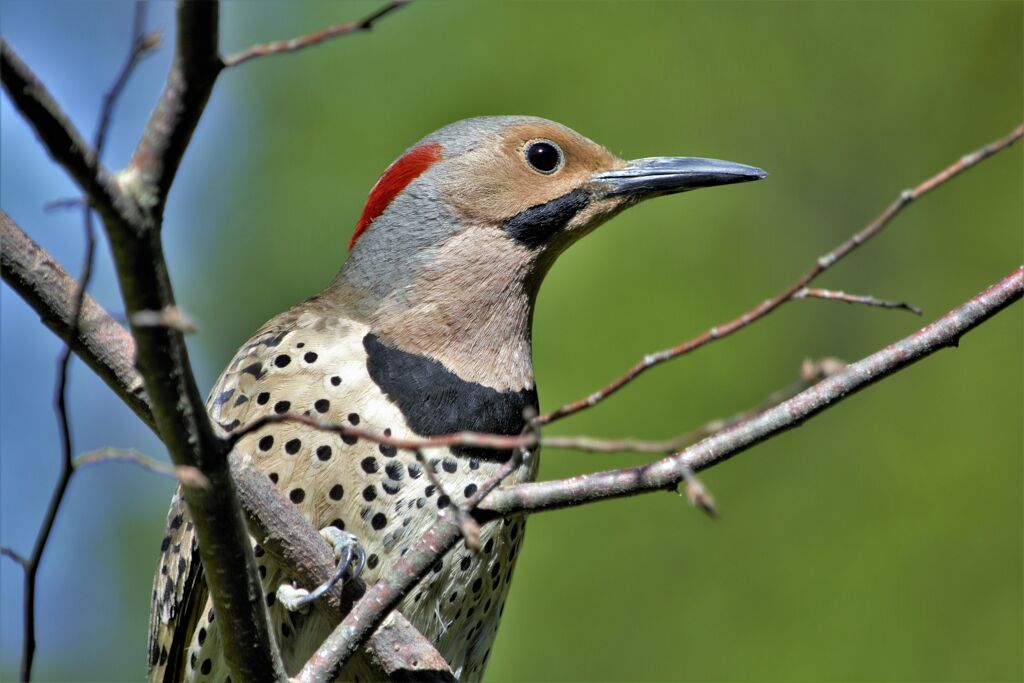
Red Billed Oxpecker
Oxpeckers, also known as tick birds, are fascinating birds with a unique symbiotic relationship with large mammals, such as cattle and big-game animals. These birds have adapted their legs to a life spent perched on mammals, removing ticks, flies, and maggots from their hides. An adult oxpecker can consume over 100 engorged ticks or 13,000 larvae daily, making them an essential part of the ecosystem. Despite their helpful nature, oxpeckers are not without controversy. While they rid animals of pests, they also take blood from sores and wounds, which may slow healing. Additionally, oxpeckers can alert their hosts to danger by hissing when alarmed.

Jackson’s Widowbird
This bird species in Kenya is medium-sized and has a dark-coloured appearance. Breeding males are easily recognizable with their distinctive long tails that curve downwards and rufous shoulders. In the non-breeding season, males shed their long tails, turning brown and streaky but maintaining their shoulder pattern. Females, on the other hand, have a brown and streaky appearance throughout the year. They usually breed in montane grasslands but can also be found in other open habitats and cultivated areas. These birds tend to move around in flocks when not breeding. Males display an unusual behaviour of jumping straight into the air during courtship. Although females may resemble other species, they are usually associated with males, whose shoulder pattern can help identify them. Non-breeding males of this bird species in Kenya might look similar to non-breeding male Fan-tailed Widowbirds, but their shoulder patch is more restricted and less orange.

Lake Nakuru’s Spectacular Pink Residents
One of Kenya’s most beloved bird species is the iconic Lesser Flamingos. These graceful birds move elegantly, creating synchronized ripples, transforming Lake Nakuru’s shoreline into a stunning pink sea. The flamingo population in Lake Nakuru underscores the importance of protecting wetlands and preserving these vital ecosystems.

Celebrating Kenya’s Avian Symphony with Evergreen Escape Expeditions
In concluding our journey through the vibrant avian wonders of Kenya, we’ve glimpsed into a world where feathers tell stories and melodies echo through the canopies. From the regal eagles ruling the skies to the graceful flamingos painting the shores of Lake Nakuru pink, Kenya’s birdlife embodies the essence of natural beauty and ecological harmony.
With Evergreen Escape Expeditions, the journey goes beyond exploration; it becomes a harmonious blend of appreciation, conservation, and immersive experiences in the heart of Kenya’s avian paradise. Book with us today and embark on a birdwatching adventure that transcends the ordinary, guided by a commitment to preserving the natural wonders that make Kenya a sanctuary for birds and birdwatchers alike.
